| Line 257: | Line 257: | ||
* [[Cleyra's Trunk]] |
* [[Cleyra's Trunk]] |
||
* [[Alexandria Castle]] |
* [[Alexandria Castle]] |
||
| + | * [[Gargan Roo]] |
||
* [[Pinnacle Rocks]] |
* [[Pinnacle Rocks]] |
||
* [[Fossil Roo]] |
* [[Fossil Roo]] |
||
Revision as of 12:08, 23 October 2018
Template:Sideicon
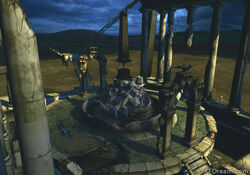
The Centra Ruins are a dungeon from Final Fantasy VIII.
Foul things lurk in forgotten places.
A dungeon (ダンジョン, Danjon?) is a game element in the Final Fantasy series where the player is to explore and obtain treasure while defeating enemies. Dungeons are usually caves or ancient ruins. The end usually has a goal: an artifact to be obtained, a boss to be defeated, or a cutscene to be seen. Sometimes the story can only progress by completing a dungeon, and sometimes they are optional.
Dungeons are usually accessed from the world map, but in some cases, they are accessed via other, smaller dungeons, either by passageways or warp devices, or in some rarer cases, the player is taken to a dungeon due to a plot event.
The final dungeon is the area where the final boss resides. Most games also feature secret, optional dungeons, that either hold precious treasure or incredibly strong superbosses.
Appearances
Final Fantasy
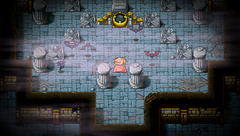
The Chaos Shrine: the first dungeon of the series.
Each dungeon contains an important artifact and a boss, with exception of the first dungeon, the Chaos Shrine, and the Mirage Tower, which is merely a path to the Flying Fortress.
List of dungeons:
- Chaos Shrine
- Marsh Cave
- Western Keep
- Cavern of Earth
- Mount Gulg
- Cavern of Ice
- Citadel of Trials
- Sunken Shrine
- Waterfall Cavern
- Mirage Tower
- Flying Fortress
- Earthgift Shrine, an earth-elemental theme optional dungeon ridden with Final Fantasy III bosses, featured in the Dawn of Souls and 20th Anniversary remakes.
- Hellfire Chasm, a fire-elemental theme optional dungeon ridden with Final Fantasy IV bosses, featured in the Dawn of Souls and 20th Anniversary remakes.
- Lifespring Grotto, a water-elemental theme optional dungeon ridden with Final Fantasy V bosses, featured in the Dawn of Souls and 20th Anniversary remakes.
- Whisperwind Cove, a wind-elemental theme optional dungeon ridden with Final Fantasy VI bosses, featured in the Dawn of Souls and 20th Anniversary remakes.
- Labyrinth of Time, an optional dungeon featured in the 20th Anniversary remake.
Final Fantasy II
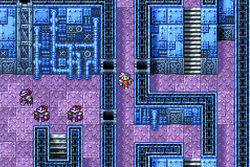
The Dreadnought.
Almost every dungeon has a boss, a key item to be obtained, or a cutscene to be seen. A point of no return in dungeons appeared for the first time. Due to the story-driven gameplay, many events take place in dungeons.
List of dungeons:
- Fynn
- Semitt Falls
- Bafsk Sewers
- Snow Cave
- Kashuan
- Dreadnought
- Deist Cavern
- Coliseum
- Fynn Castle
- Tropical Island
- Cave of Mysidia
- Leviathan
- Mysidian Tower
- Cyclone
- Palamecia
- Jade Passage
- Unknown Cave, a post-game optional dungeon featured in the Dawn of Souls and 20th Anniversary remakes.
- Unknown Palace, a post-game optional dungeon featured in the Dawn of Souls and 20th Anniversary remakes.
- Arcane Labyrinth, an optional dungeon featured in the 20th Anniversary remake.
- Arcane Sanctuary, an optional dungeon featured in the 20th Anniversary remake.
Final Fantasy III
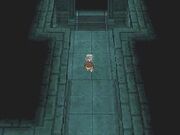
The Temple of Time.
There is one boss per dungeon, optional dungeons appeared for the first time, and cutscenes occur in each dungeon. In some dungeons, the party is forced to induce a status ailment to transfigure the party so they can enter, such as the Subterranean Lake or the Tower of Owen.
List of dungeons:
- Altar Cave
- Sealed Cave
- Dragon's Peak
- Nepto Temple
- Tower of Owen
- Subterranean Lake
- Molten Cave
- Hein's Castle
- Cave of Tides
- Amur Sewers
- Goldor Manor
- Cave of the Circle
- Temple of Time
- Ancient Ruins
- Cave of Shadows
- Doga's Grotto
- Ancients' Maze
- Crystal Tower
- Dragon Spire, an optional dungeon that holds treasured equipment for Dragoons.
- Sunken Cave, an optional dungeon that holds many treasure.
- Saronia Catacombs, an optional dungeon that consists of Odin's residence.
- Lake Dohr, an optional dungeon that consists of Leviathan's residence.
- Bahamut's Lair, an optional dungeon that consists of Bahamut's true lair.
- Forbidden Land Eureka, an optional dungeon that holds sealed powerful equipment.
- ???, an optional dungeon featured in the 3D versions.
Final Fantasy IV
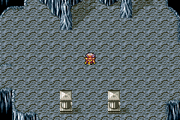
The Lunar Ruins.
Party members often leave and join the party inside dungeons.
List of dungeons:
- Mist Cave
- Underground Waterway
- Antlion's Den
- Mt. Hobs
- Mount Ordeals
- Ancient Waterway
- Lodestone Cavern
- Tower of Zot
- Cave of Eblan
- Tower of Babil
- Sealed Cave
- Giant of Babil
- Sylph Cave, an optional dungeon located in the Earth.
- Feymarch, an optional dungeon that leads to the home of the Eidolons.
- Lair of the Father, an optional dungeon which is Bahamut's lair.
- Cave of Trials, an optional dungeon located in Mount Ordeals that features new equipment in the Advance remake.
- Lunar Ruins, a long and difficult optional dungeon located in the Red Moon that houses new puzzles, equipment and enemies. It is available in the Advance and Complete Collection remakes.
Final Fantasy IV -Interlude-
Dungeons cannot be revisited after leaving the area via the Falcon, because the game is short and linear.
List of dungeons:
Final Fantasy IV: The After Years
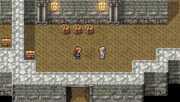
Tower of Trials.
Every dungeon with the exception of the Giant of Babil appear. While many dungeons return untouched, new ones have been added, and some existing ones have been expanded. A new series of optional dungeons named Challenge Dungeons appear in each character's tale.
List of additions:
- Adamant Isle Grotto was expanded and turned into the initial dungeon of Ceodore's Tale.
- The Devil's Road was expanded and turned into a new dungeon.
- The Mist Cave was expanded, now featuring an underground area, which is explored in the end of Ceodore's Tale.
- The Agart Mine was added to the Agart Volcano, and is explored in the end of Rydia's Tale.
- The Impact Crater was added and is located between Mt. Hobs and Damcyan.
- The Adamant Isles Forest was added and is explored in the end of Yang's Tale.
- The Tower of Trials was added south of Troia and is explored in the beginning of Palom's Tale.
Final Fantasy V
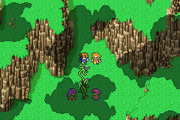
The Drakenvale.
Plot events became more common at the end of dungeons than the acquisition of key items.
List of dungeons:
- Pirates' Hideout
- Wind Shrine
- Ship Graveyard
- North Mountain
- Walse Tower
- Fire-Powered Ship
- Library of the Ancients
- Ronka Ruins
- Castle Exdeath
- Underground Waterway
- Drakenvale
- Barrier Tower
- Pyramid of Moore
- Island Shrine
- Great Sea Trench
- Istory Falls
- Gil Cave, an optional dungeon from the second world.
- Castle of Bal, an optional dungeon from the third world, where Odin lies.
- Fork Tower, an optional dungeon from the third world that houses the spells Holy and Flare.
- Phoenix Tower, an optional dungeon from the third world where Phoenix can be obtained.
- Sealed Temple, an optional dungeon available in the Advance, mobile and Steam versions, composed by several smaller dungeons.
Final Fantasy VI
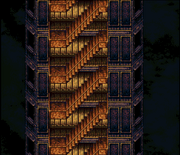
The Cultists' Tower.
The use of dungeons as pathways is common in the World of Balance, while the World of Ruin is filled with optional dungeons that reward with a playable character, and in rare cases, magicite.
List of dungeons:
- Narshe Mines
- South Figaro Cave
- Mt. Kolts
- Lethe River
- Phantom Forest
- Phantom Train
- Baren Falls
- Crescent Mountain Cave
- Serpent Trench
- Zozo
- Magitek Research Facility
- Cave to the Sealed Gate
- Espers' Gathering Place
- Floating Continent
- Figaro Castle
- Darill's Tomb
- Mt. Zozo is an optional dungeon in the World of Ruin.
- Owzer's Mansion is an optional dungeon in the World of Ruin where Relm Arrowny can be found.
- Cave on the Veldt is an optional dungeon in the World of Ruin where Gau can be found.
- Cultists' Tower is an optional dungeon where Strago Magus can be found that rewards the player with a Soul of Thamasa.
- The Phoenix Cave is an optional dungeon where Locke Cole and the Phoenix magicite can be found.
- Cyan's Soul is an optional dungeon that rewards the player with Alexander.
- Ebot's Rock is an optional dungeon where Strago can learn Grand Delta.
- Zone Eater's Belly is an optional dungeon where Gogo can be found.
- Narshe becomes a dungeon in the World of Ruin where Mog can be found.
- Yeti's Cave is a continuation of the Narshe Mines accessible in the World of Ruin where Midgardsormr and Umaro can be found.
- Dragons' Den, an optional dungeon featured in the Advance, mobile and Steam versions.
- Soul Shrine, an optional dungeon featured in the Advance, mobile and Steam versions.
Final Fantasy VII
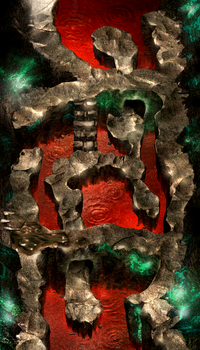
The depths of the Cave of the Gi.
Many dungeons appear as either a passage or an optional dungeon. Items are scarce.
List of dungeons:
- Sector 1 Reactor
- Sector 5 Reactor
- Train Graveyard
- Shinra Headquarters
- Mythril Mine
- Mt. Corel
- Cave of the Gi
- Mt. Nibel
- Temple of the Ancients
- Corel Valley Cave
- Great Glacier
- Gaea's Cliff
- Junon Underwater Reactor
- Midgar, the second visit is one extended dungeon from which the player cannot escape.
- Ancient Forest, an optional dungeon with several treasures.
- Sunken Gelnika, an optional dungeon underwater with precious equipment.
Final Fantasy VIII
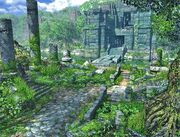
The Tomb of the Unknown King.
Dungeons either end in plot events, or are optional. Many of the dungeons later in the game are points of no return. Many of the town areas also offer dungeon-type gameplay of fulfilling objectives and killing monsters, before usually returning to being towns.
List of dungeons:
- Fire Cavern
- Centra Excavation Site
- Tomb of the Unknown King
- Deling City Sewers
- D-District Prison
- Missile Base
- Balamb Garden
- Galbadia Garden
- Great Salt Lake
- Ragnarok
- Lunatic Pandora
- Ultimecia Castle
- Centra Ruins, an optional dungeon on the Centra continent.
- Deep Sea Research Center, an optional dungeon in the edge of the world.
Final Fantasy IX
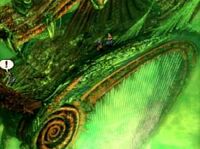
The Iifa Tree.
Many different dungeons appear.
List of dungeons:
- Evil Forest
- Ice Cavern
- Gizamaluke's Grotto
- Burmecia
- Cleyra's Trunk
- Alexandria Castle
- Gargan Roo
- Pinnacle Rocks
- Fossil Roo
- Conde Petie Mountain Path
- Iifa Tree
- Oeilvert
- Desert Palace
- Mount Gulug
- Ipsen's Castle
- Earth Shrine
- Pandemonium
- Memoria
- Crystal World
Final Fantasy X
The world map has been abolished as such not many dungeons appear. Via Purifico, Mt. Gagazet, and Inside Sin are mandatory dungeons. Cloister of Trials|Cloisters of Trials also has dungeon-like appearance and require completing a task to continue with the story. The Cavern of the Stolen Fayth and the Omega Ruins are optional dungeons.
Final Fantasy X-2
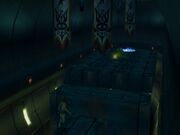
Via Infinito.
Many dungeons appear and require various puzzles to be solves.
- Mt. Gagazet
- Chateau Leblanc
- Bevelle Underground
- Farplane
- Cavern of the Stolen Fayth
- Ruin Depths
- Fiend Colony
- Cactuar Hollow
- New Cave
- Via Infinito
- Den of Woe
Final Fantasy X-2: Last Mission
Final Fantasy XI
Many dungeon areas are distinguished by enemies re-spawning more slowly, players being able use the spell Escape, and chocobos not entering them. Almost all dungeons are at one point used in a mission or quest:
Original dungeons
- Inner Horutoto Ruins
- Outer Horutoto Ruins
- Toraimarai Canal
- Giddeus
- Maze of Shakhrami
- Castle Oztroja
- Garlaige Citadel
- King Ranperre's Tomb
- Ghelsba Outpost
- Fort Ghelsba
- Yughott Grotto
- Ordelle's Caves
- Davoi
- Monastic Cavern
- The Eldieme Necropolis
- Zeruhn Mines
- Dangruf Wadi
- Palborough Mines
- Gusgen Mines
- Beadeaux
- Crawlers' Nest
- Lower Delkfutt's Tower
- Middle Delkfutt's Tower
- Upper Delkfutt's Tower
- Ranguemont Pass
- Fei'Yin
- Castle Zvahl Baileys
- Castle Zvahl Keep
Rise of the Zilart
- Korroloka Tunnel
- Quicksand Caves
- Kuftal Tunnel
- Gustav Tunnel
- Labyrinth of Onzozo
- Sea Serpent Grotto
- Temple of Uggalepih
- Den of Rancor
- Ifrit's Cauldron
- The Boyahda Tree
- Ve'Lugannon Palace
- The Shrine of Ru'Avitau
Chains of Promathia
- Promyvion - Dem
- Promyvion - Holla
- Promyvion - Mea
- Promyvion - Vahzl
- Phomiuna Aqueducts
- Sacrarium
- Riverne - Site A01
- Riverne - Site B01
- Pso'Xja
- Oldton Movalpolos
- Newton Movalpolos
- Grand Palace of Hu'Xzoi
- The Garden of Ru'Hmet
Treasures of Aht Urhgan
Wings of the Goddess
- Garlaige Citadel [S]
- Crawlers' Nest [S]
- The Eldieme Necropolis [S]
- Castle Oztroja [S]
- Beadeaux [S]
- La Vaule [S]
- Castle Zvahl Baileys [S]
- Castle Zvahl Keep [S]
Seekers of Adoulin
Final Fantasy XII
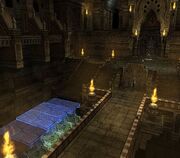
Tomb of Raithwall.
Dungeons can be distinguished by areas that cannot be accessed via the Strahl.
List of dungeons:
- Garamsythe Waterway
- Nalbina Dungeons
- Barheim Passage
- Lhusu Mines
- Dreadnought Leviathan
- Tomb of Raithwall
- Henne Mines
- Stilshrine of Miriam
- Sochen Cave Palace
- Draklor Laboratory
- Feywood
- Giruvegan
- Great Crystal
- Pharos
- Subterra, an optional dungeon below the Pharos.
- Zertinan Caverns, an optional dungeon that links numerous locations in eastern Ivalice.
- Necrohol of Nabudis, an optional dungeon that was once a city of men, now it is filled with evil spirits.
Final Fantasy XII: Revenant Wings
Gameplay is restricted to battles and does not have many dungeons. The Well of Whispered Oaths has several enemies, treasures and floors, and thus, can be considered a legitimate dungeon.
Final Fantasy XIII
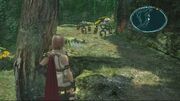
Faultwarrens.
The traditional concept of dungeons largely doesn't exist. On Gran Pulse, however, there are a few optional areas the player can explore, the Faultwarrens being closest to a traditional dungeon.
Final Fantasy XIII-2
There are no clear dungeon areas. However, Augusta Tower harkens back to classical tower dungeons from the series with its puzzles.
Lightning Returns: Final Fantasy XIII
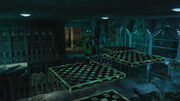
Temple of the Goddess.
To complete the area's main quest, the player typically needs to defeat the boss at the end of a dungeon.
List of dungeons:
- Patron's Palace
- Temple of the Goddess
- Temple Ruins
- Ultimate Lair, an optional dungeon only available on the extra day.
Final Fantasy XIV 1.0
Dungeons were a form of duties where a group of four or eight adventurers explored and worked together to defeat enemies, find treasure and complete objectives. Dungeons could only be entered after progressing to a certain point in a quest. The player could then join other player characters to make a party of four or eight (depending on the dungeon), either by inviting members or by using the Duty Finder, before they could access the dungeon. A four-player party had to contain two DPS, one healer and one tank class, whereas an eight-player party had to contain four DPS, two healers and two tank classes.
All dungeons had a recommended level, and players whose level was below the recommended would be denied entry. Players at least four levels higher than the recommended level had their level synced to three levels higher, meaning their stats and the power of their equipment was lowered while inside the dungeon.
Once inside the party had ninety minutes to complete all objectives, or they were ejected. As with other instanced duties, players could not change their class or job while inside, and whenever they were KO'd, they had the option to revive at the start of the dungeon.
Dungeons typically had three or four boss areas, and engaging any enemy within these areas started a ten-second countdown, after which the area's exits were blocked until either all enemies were defeated, or the party was wiped out. There was a boss at the end and its defeat revealed the exit, successfully completing the duty.
Final Fantasy XV
Many dungeons appear, several of which contain royal tombs at the end where Noctis can acquire Royal Arms. Most dungeons have quests associated with them with recommended levels, though it is possible to enter many of them without the associated quest or far below the recommended level. Many of these dungeons also contain a sealed door which leads to a secondary dungeon containing extremely powerful monsters that can only be accessed after completing the main story, for the sidequest Menace Beneath Lucis. Given the name of the sidequest, these bonus dungeons are often referred to as "Menace" dungeons by the playerbase, such as Keycatrich Menace or Costlemark Menace.
Dungeons have their own maps and the player cannot save the game once inside unless they find a haven, which fill the role of save points. Most, but not all, dungeons give the player the option to return to the entrance from the save screen.
Main quest dungeons (with associated quest level)
- Hill overlooking Insomnia (Lv 4)
- Keycatrich Trench (Lv 6)
- Norduscaen Blockade (Lv 8)
- Greyshire Glacial Grotto (Lv 19)
- Disc of Cauthess (Lv 20)
- Fociaugh Hollow (Lv 22)
- Aracheole Stronghold (Lv 23)
- Fort Vaullerey (Lv 25)
- Steyliff Grove (Lv 26)
- EXINERIS Power Plant (Lv 27)
- Fodina Caestino (Lv 33)
- Zegnautus Keep (Lv 38-40)
- Insomnia (Lv 45)
Sidequest dungeons (with associated quest level)
- Nebulawood (Lv 15)
- Daurell Caverns (Lv 28)
- Rock of Ravatogh (Lv 30)
- Malmalam Thicket (Lv 35)
- Myrlwood (Lv 36)
- Crestholm Channels (Lv 45)
- Formouth Garrison (Lv 46)
- Balouve Mines (Lv 50)
- Costlemark Tower (Lv 55)
- Keycatrich Menace (Lv 55)
- Pitioss Ruins (Lv 60*Pitioss contains no enemies, rendering the recommended level moot)
- Greyshire Menace (Lv 65)
- Fociaugh Menace (Lv 65)
- Daurell Menace (Lv 72)
- Balouve Menace (Lv 78)
- Steyliff Menace (Lv 86)
- Crestholm Menace (Lv 92)
- Costlemark Menace (Lv 99)
Final Fantasy Tactics
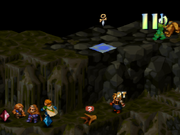
Midlight's Deep.
Gameplay is limited to battles and the world map. Midlight's Deep, however, is said to be a large dungeon. To reach all ten levels the player must find the exit on each level mid-battle. At the bottom level is the lone superboss, Elidibus.
Final Fantasy Type-0
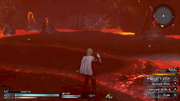
Mount Jubanla.
Dungeons are usually optional, and there may be tasks given by NPCs to defeat the monsters within, or to obtain certain items. In dungeons a quest arrow leads the player into the final battle room, and once the enemies there are defeated, the arrow leads the player back to the entrance. Throughout the dungeon the player can collect treasures and collectibles, the most common being Knowing Tags. Many dungeons have such high level enemies they are best tackled in New Game Plus.
List of dungeons:
- Corsi Cave
- Northern Corridor
- Bethnel Caverns
- Black Tortoise Crevasse
- Ultima Ground Zero
- Mount Jubanla
- Innsmouth Coast
- Silent Key
- Valley of Monsters
- Tower of Agito
Final Fantasy Mystic Quest
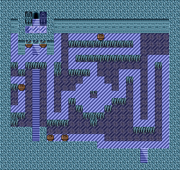
Ice Pyramid.
Consumable items and ammo are found within the brown wooden chests scattered throughout the dungeons that respawn when exiting to the world map. Monsters are also respawn in the same way as the chests.
List of dungeons:
- Level Forest
- Bone Dungeon
- Wintry Cave
- Falls Basin
- Ice Pyramid
- Mine
- Volcano
- Lava Dome
- Alive Forest
- Giant Tree
- Mount Gale
- Pazuzu's Tower
- Mac's Ship
- Doom Castle
Theatrhythm Final Fantasy Curtain Call
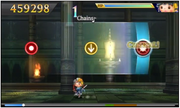
The Shrine
A "Shrine", which closely resembles a dungeon, appears as the FMS for several final dungeon themes throughout the series:
- Sunken Shrine*from Final Fantasy
- Tower of the Magi*from Final Fantasy II
- The Castle*from Final Fantasy VIII
- Via Purifico*from Final Fantasy X
- Heaven's Tower*from Final Fantasy XI
- The Bevelle Underground*from Final Fantasy X-2
- The Farplane Abyss*from Final Fantasy X-2
- Eclipse*from Final Fantasy XIII-2
Final Fantasy Adventure
Each dungeon contains numerous enemies, and some enemies found in earlier dungeons will continue to make an appearance in later dungeons.
List of dungeons:
- Glaive Castle
- Cave of Marsh
- Old Mine
- Gaia Pass
- Glaive's Airship
- Cave of Medusa
- Davias' Mansion
- Mt. Rocks
- Cara Mountain Range
- Undersea Volcano
- Cave in Floatrocks
- Sealed Cave
- Cave of Ruins
- Dime Tower
- Temple of Mana
- Mana Shrine
Final Fantasy Legend II
Each dungeon contains important items and sometimes a boss has to be defeated. Countless items, weapons, and armor can be found throughout these dungeons.
List of dungeons:
- Cave of North
- Relics of the Ancient Gods
- Ashura's Base
- Ki's Body
- Ashura's Tower
- Abandoned Giant's Town
- Cave of Mountain
- Undersea Volcano
- Cave of Light
- Guardian's Base
- Sewer
- Volcano
- Race Course
- Harbor
- Edo Castle
- Nasty Dungeon (Optional)
- Valhalla Palace
- Final Dungeon
Final Fantasy Legend III
Almost every dungeon has a boss to defeat, and/or an important item to be obtained. There are also a number of optional dungeons to explore which are simple to navigate and contains valuable treasures.
List of dungeons:
- North Tower
- Southeast Cave
- South Tower
- Castle of Chaos
- Shipwrecks (Optional)
- Northern Ruins
- Mountain
- Maitreya's Tower
- North Maze
- Mt. Hasbid
- Southwest Ruins
- Mushrooms (Optional)
- Crevasse
- Shedding of Jorgandr (Optional)
- West Tower (Optional)
- Eastern Ruins
- Caves (Optional)
- Mt. Goht
Final Fantasy Dimensions
Bravely Default
A majority of the dungeons are optional, as they can only be found during sidequests.
List of dungeons:
- Norende Ravine
- Ruins of Centro Keep
- Lontano Villa
- Harena Ruins
- Vestment Cave
- Temple of Wind
- Grand Mill Works
- Miasma Woods
- Florem Gardens
- Mount Fragmentum
- Witherwood
- Twilight Ruins
- Temple of Water
- Grapp Keep
- Starkfort
- Mythril Mines
- Underflow
- Temple of Fire
- Engine Room
- Eternian Central Command
- Everlast Tower
- Vampire Castle
- Dimension's Hasp, an optional dungeon on the Kustra Archipelago.
Bravely Second: End Layer
A number of dungeons appear and require puzzles to be solved and a fair amount of backtracking.
- Pilgrim's Grove
- Frozen Hollows
- Ba'al Crater
- Harena Sea Caves
- Old Aqueduct
- Geyser Grotto
- Sagitta Forest
- Old Sagitta
- Skyhold
- Geneolgia Crypts
Final Fantasy Record Keeper
A dungeon is the record of an event from the series. Each consists of one or more battle rounds, each representing a particular area within the event. Each round has a Stamina value that must be expended by the player to play. Most dungeons have a boss area requiring slightly more Stamina than other areas, and a relative few dungeons have more than one boss area. The core objective is to complete each area as efficiently as possible while taking the least damage. Meeting this combined objective to any degree earns Chocobo Medals; the more Medals earned, the better the player's ranking in the dungeon.
This layout forces the player to think somewhat strategically, as one is not only limited by his or her total Stamina, but also by the number of charges remaining on the party's Abilities. Target Scores worth three Chocobo Medals each are awarded for actions in a boss area. Thus, it is common for a player to store Ability charges until a boss area is reached.
Completing dungeons earns various rewards. Completion Rewards are always available, and usually include gil. Additional First-Time Rewards are bestowed on the player's first visit to the dungeon. Special Mastery Rewards are collected once the player earns enough Medals to qualify as a Champion (Excellent in Japanese).
There are over 250 dungeons in the standard game, plus a variable number by way of active events. Most are divided into Classic Dungeons and Elite Dungeons, each with progressive levels of difficulty.
Musical themes
The early series had a "Dungeon" theme, but as the series evolved, each dungeon began to have its own background theme. In compilation-style games, such as Final Fantasy Record Keeper, the source material determines the dungeon theme.
In Final Fantasy Record Keeper, the original 8-, 16-, and 24-bit music tracks are used despite many games having been remastered and re-scored, in effect adding to the game's nostalgic feel.
Trivia
- In Final Fantasy XV, the sealed doors that lead to optional dungeons have many similarities with the Cavern of Remembrance in Kingdom Hearts.
- Both are optional side quests that yield powerful items
- Monsters or Heartless/Nobodies found in these areas are similar in appearance, if not the same, to monsters and Heartless/Nobodies found in the outside world. The only difference is they are much more powerful.
Template:Navbox recurring elements
